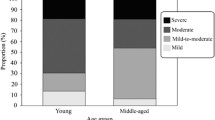Summary
In contrast to the impressive advances made in somatic research of erectile dysfunction (ED), psychogenic ED is mostly treated as a monolithic block or is merely defined by exclusion of organic factors. This paper proceeds from the assumption that a classification of psychological subtypes of ED is urgently needed and has to include a categorization of different pathogenetic mechanisms as well as a classification of interaction patterns with somatic risk factors. After a brief review of current approaches, psychological subtypes of ED are examined along two different lines of evidence. First, 236 consecutive patients from an ED outpatient unit were included in a cluster analysis to identify homogeneous subgroups of cases. Three clusters emerged, whose main characteristics as well as most important discriminating variables were further explored by various statistical procedures. Second, on the basis of clinical experience a four-level model of psychogenic ED is proposed that consists of dispositional, etiologic, pathogenetic, and maintaining factors. In addition, four different pathogenetic modes of psychogenic ED are differentiated, which have been labeledactual-neurotic, psychoneurotic, psychosomatic, andfunctional. Conclusions concentrate on these modes as well as on the empirical subtypes and their implications for clinical practice and future research. Our results indicate that we are just beginning to understand the complex pathogenetic interface between psychological factors and manifest ED.
Similar content being viewed by others
References
Bancroft J (1993) But what is psychogenic erectile dysfunction? Int J Impotence Res 5: 205–206
Bancroft J (1994) What is psychogenic erectile dysfunction? Paper presented at the 2nd conference of the European Federation of Sexology, Copenhagen, June 2–5, 1994
Barlow DH (1986) Causes of sexual dysfunction: the role of anxiety and cognitive interference. J Consult Clin Psychol 54: 140–148
Hartmann U (1994) Diagnostik und Therapie der erektilen Dysfunktion. Lang, Frankurt/Main
Janssen E, Bancroft J (1996) Dual control of sexual response: the relevance of central inhibition. Paper presented at the 22nd meeting of the International Academy of Sex Research, Rotterdam, June 26–30, 1996
Janssen E, Everaerd W (1993) Determinants of male sexual arousal. In: Bancroft J (ed) Annual review of sex research, vol 4. Mount Vernon, SSSS, pp 211–245
Kaplan HS (1979) Disorders of sexual desire. Brunner/Mazel, New York
Langer D, Hartmann U (1992) Psychosomatik der Impotenz. Enke, Stuttgart
Levine SB, Althof SE (1991) The pathogenesis of psychogenic erectile dysfunction. J Sex Educ Ther 17: 251
Lue TF (1993) Erectile dysfunction: problems and challenges. J Urol 149: 1256–1257
National Institutes of Health (1992) Consensus development conference statement on impotence. National Institutes of Health, Bethesda, Maryland
Sbrocco T, et al. (1992) Behavioral subtypes of sexually dysfunctional males: preliminary results and treatment implications. Paper presented at the annual meeting of the Association for the Advancement of Behavior Therapy, Washington, D.C., November, 1992
Author information
Authors and Affiliations
Rights and permissions
About this article
Cite this article
Hartmann, U. Psychological subtypes of erectile dysfunction: results of statistical analyses and clinical practice. World J Urol 15, 56–64 (1997). https://doi.org/10.1007/BF01275158
Issue Date:
DOI: https://doi.org/10.1007/BF01275158




